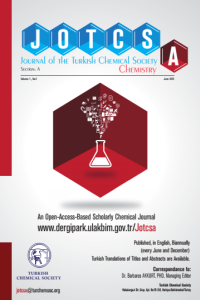Abstract
References
- Sarıışık A, Tozaçan B, Davraz M, Uğur İ, Çankiran O. Pumice technology. Süleyman Demirel University. İsbaş 1998.
- Çevikbaş A, İlgün F. Geology and Economics of Turkey Pumice. 1st Pumice Symposium Of Isparta, 26 – 28 June 1997, Isparta, Turkey, 13-18.
- İlhan S, Nurbaş M, Ekmekçi S, Özdag H. Use of Pumice as Adsorbent in Biotechnology. 1st Pumice Symposium Of Isparta, 26-28 June 1997, Isparta, Turkey, 39-46.
- Tözüm S. Removal of Pollutants From Olive Wastewater (Karasu) With Pumice by Adsorption [Master Thesis]. Isparta: Süleyman Demirel University; 2009.
- Bardakçı B, Çiçek E. Use of Isparta Pumice for the Removal Radioactive Waste by Adsorption. Turkey Pumice Symposium and Exhibition, 15-17 September 2005, Isparta, Turkey, 335-338.
- Geitgey RP. Industrial minerals and rocks. 6. th Edition. Colorado: Society for Mining Metalurgy and Exploration Inc. Littleton; 1994. p.803-813.
- Aksay EK. Investigation of the Technological Properties of the İzmir-Menderes Pumice Ore. İzmir: Dokuz Eylül University; 2005.
- Reyhanoğlu M. Pumice and Its Uses [Master Thesis]. Adana: Çukurova University; 1988.
- Yanık S. The usability of Basic Pumice as a Concrete Aggregate [Master Thesis]. Adana: Çukurova University; 2007.
- Çiftçi E. Dictionary of Technical Terms of Earth Sciences. Niğde; 2003.
- Kuşçu M, Gedikoğlu. Geological position of regional pumices of Isparta-Gölcük. Engineering Geology Journal 1990 37: 69-78.
- Özcan Y, Ulusoy E. Textile Fiber and Dyeing Technique. Number: 2557 Series: 39. İstanbul: İstanbul University; 1978. p. 371-376.
- Başer İ. ve İnanıcı, Y. Chemistry Of Dyes. İstanbul: Marmara University; 1990.
Abstract
Toxic
effect of textile dyes their increasing quantities in air, soil and
water environments, because of growing of industrial actives, they
must be taken into consideration since they harm to environment. We
come across textile dyes in natural wetlands as result of
uncontrolled industrial wasted. Textile dyes that can accumulate
easily in their environments may show toxic effects.
Pumice,
accruing as result of volcanic events and durable against chemical
factors, is a rock that has porous structure. Pumices have a porous
structure because of sudden cooling of the rock and sudden leaving of
gases a result of volcanic events. Thanks to these pores, pumices
heat and sound insulation are quite high. The most distinctive
feature of pumice from other rocks is that it has different colors
and there is not crystal water in its porous structure.
Adsorption
studies are applied with Van Pumice at pH = 6, the adsorption
mechanism and changing metal concentration. As result of these
researches, it has been found that there are different adsorption
movements at pH 6 between textile dyes and Van Pumice. The
result of this study shows that the Pumice found in Lake Van gives a
better fit for the Langmuir Isotherm (model) and the amount of
adsorption increases with the temperature.
It
is thereby concluded that the Pumice located in Lake Van is a
recommended adsorbent for filtering the used textile dye in aqueous
medium.
Keywords
References
- Sarıışık A, Tozaçan B, Davraz M, Uğur İ, Çankiran O. Pumice technology. Süleyman Demirel University. İsbaş 1998.
- Çevikbaş A, İlgün F. Geology and Economics of Turkey Pumice. 1st Pumice Symposium Of Isparta, 26 – 28 June 1997, Isparta, Turkey, 13-18.
- İlhan S, Nurbaş M, Ekmekçi S, Özdag H. Use of Pumice as Adsorbent in Biotechnology. 1st Pumice Symposium Of Isparta, 26-28 June 1997, Isparta, Turkey, 39-46.
- Tözüm S. Removal of Pollutants From Olive Wastewater (Karasu) With Pumice by Adsorption [Master Thesis]. Isparta: Süleyman Demirel University; 2009.
- Bardakçı B, Çiçek E. Use of Isparta Pumice for the Removal Radioactive Waste by Adsorption. Turkey Pumice Symposium and Exhibition, 15-17 September 2005, Isparta, Turkey, 335-338.
- Geitgey RP. Industrial minerals and rocks. 6. th Edition. Colorado: Society for Mining Metalurgy and Exploration Inc. Littleton; 1994. p.803-813.
- Aksay EK. Investigation of the Technological Properties of the İzmir-Menderes Pumice Ore. İzmir: Dokuz Eylül University; 2005.
- Reyhanoğlu M. Pumice and Its Uses [Master Thesis]. Adana: Çukurova University; 1988.
- Yanık S. The usability of Basic Pumice as a Concrete Aggregate [Master Thesis]. Adana: Çukurova University; 2007.
- Çiftçi E. Dictionary of Technical Terms of Earth Sciences. Niğde; 2003.
- Kuşçu M, Gedikoğlu. Geological position of regional pumices of Isparta-Gölcük. Engineering Geology Journal 1990 37: 69-78.
- Özcan Y, Ulusoy E. Textile Fiber and Dyeing Technique. Number: 2557 Series: 39. İstanbul: İstanbul University; 1978. p. 371-376.
- Başer İ. ve İnanıcı, Y. Chemistry Of Dyes. İstanbul: Marmara University; 1990.
Details
| Subjects | Engineering, Chemical Engineering |
|---|---|
| Journal Section | Articles |
| Authors | |
| Publication Date | April 4, 2017 |
| Submission Date | February 17, 2017 |
| Acceptance Date | April 3, 2017 |
| Published in Issue | Year 2017 Volume: 4 Issue: 2 |


